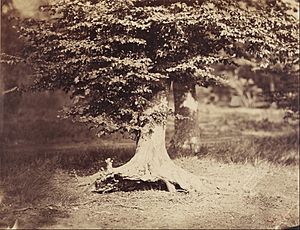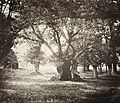Gustave Le Gray facts for kids
Quick facts for kids
Gustave Le Gray
|
|
|---|---|
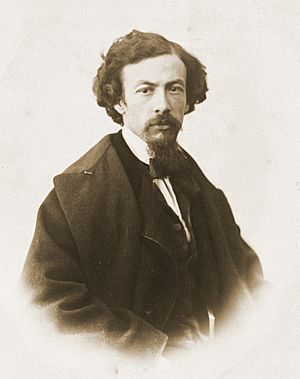
Gustave Le Gray, Self-portrait, late 1850s
|
|
| Born | 30 August 1820 Villiers-le-Bel, Val-d'Oise, France
|
| Died | 30 July 1884 (aged 63) Cairo, Egypt
|
| Known for | Painter, draughtsman, sculptor, print-maker, photographer |
|
Notable work
|
Developed a number of photographic techniques |
| Spouse(s) |
Palmira Maddalena Gertrude Leonardi
(m. 1844) |
Jean-Baptiste Gustave Le Gray (born August 30, 1820 – died July 30, 1884) was a French artist. He was a painter, a draughtsman (someone who draws), a sculptor, and a print-maker. But he is most famous as a photographer. Many people call him "the most important French photographer of the nineteenth century." This is because he invented new ways to take pictures. He also taught other famous photographers. Plus, he had a great imagination when creating his photos. He helped a lot in developing the wax paper negative, which was a new way to make photos.
Contents
About Gustave Le Gray
Gustave Le Gray was born on August 30, 1820, in a town called Villiers-le-Bel in France. He was the only child in his family. His parents wanted him to become a lawyer's assistant. But from a young age, Gustave dreamed of being an artist.
He first trained as a painter. He studied with famous teachers like François-Édouard Picot and Paul Delaroche. His parents paid for him to travel to Switzerland and Italy. He lived in Italy from 1843 to 1846. There, he painted portraits of people and scenes of the countryside. In 1844, he met and married Palmira Maddalena Gertrude Leonardi. She was a laundress. They had six children together, but only two lived to be adults.
Le Gray showed his paintings at a famous art show in Paris called the Salon in 1848 and 1853. After that, he started working with photography. This was when photography was still very new.
Early Photography Work
He made his first daguerreotypes by 1847. Daguerreotypes were early types of photographs made on a silver-coated copper plate. His first photos included:
- Portraits of people.
- Nature scenes, like the Fontainebleau Forest.
- Buildings, such as the beautiful châteaux (castles) in the Loire Valley.
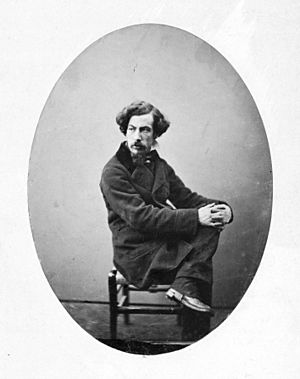
Gustave Le Gray also taught photography to many students. Some of them became famous photographers themselves. These included Charles Nègre, Henri Le Secq, Nadar, Olympe Aguado, and Maxime Du Camp.
In 1851, he was one of the first five photographers chosen for the Missions Héliographiques. This was a special project by the French government. Their job was to photograph important French monuments and buildings. In the same year, he helped start the Société Héliographique. This was the "first photographic organization in the world." Le Gray also wrote a book about photography. It was so popular that it was printed four times, in 1850, 1851, 1852, and 1854.
Later Career and Travels
In 1855, Le Gray opened a very fancy photography studio. He became the official photographer for Napoléon III, who was the Emperor of France. This made him a very successful portrait photographer. His most famous pictures are from 1856 to 1858, especially his seascapes (pictures of the sea).
Even though his art was successful, his business was not good with money. It ran into many debts. Because of these financial problems, he closed his studio and left France in 1860.
He began traveling around the Mediterranean Sea in 1860. He traveled with the famous writer Alexandre Dumas, père, who wrote The Three Musketeers. During their trip, they met Giuseppe Garibaldi. Garibaldi was a famous Italian general and politician. Le Gray took striking pictures of Garibaldi and the city of Palermo during a battle. These pictures quickly became famous across Europe.
Dumas left Le Gray and the other travelers in Malta. He joined the revolutionary forces. Le Gray then went to Lebanon and Syria. In 1861, he took photos of the French army's movements for a magazine. He got injured there and stayed for a while. After that, he went to Egypt. In Alexandria, Egypt, he photographed important people like Henri, Count of Chambord and the future Edward VII of the United Kingdom. He also sent pictures to his friend Nadar back in France.
In 1864, Le Gray settled in Cairo, Egypt. He made a living as a drawing teacher and had a small photography shop. He sent pictures to a big exhibition in 1867, but they didn't get much attention. He did get some special jobs from the vice-king Isma'il Pasha. About 50 pictures from this later time still exist today.
In 1868, a rich art collector named Chauncy Hare Townshend gave a collection of Le Gray's seascape photographs to the Victoria and Albert Museum in London. These photos were kept very carefully. They stayed in excellent condition, almost like new, for many years.
Gustave Le Gray died on July 30, 1884, in Cairo. His only surviving child from his marriage to Palmira Leonardi, named Alfred, became his heir.
Technical Innovations
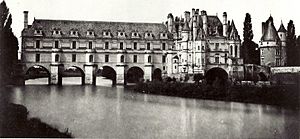
Gustave Le Gray was very clever and invented new ways to improve photography. His important technical inventions included:
- Improved Paper Negatives: He found a way to wax paper negatives before taking the picture. This made the paper much better at capturing tiny details.
- Collodion Process: In 1850, he wrote about a new way to make photos using a substance called collodion. However, the invention of the "wet collodion method" using glass plates is now given to Frederick Scott Archer. Archer published his process in 1851.
- Combination Printing: He was one of the first to use a special trick called combination printing. For his famous seascapes, he would use one negative (the original photo plate) for the water and a separate negative for the sky. This helped him get both parts of the picture perfectly exposed.
Famous Works
Le Gray took many photos for the French government. He documented important French monuments and buildings.
He was also a very successful portrait photographer. He took pictures of famous people like Napoléon III and Edward VII. He became especially famous for his seascapes, which are pictures of the sea. He lived in Cairo, Egypt, for 20 years, but not many of his works from that time have survived.
World Records for Most Expensive Photographs
Gustave Le Gray's photographs have set world records for their high prices.
- In October 1999, a photo by Le Gray called "Beech Tree, Fontainebleau" was sold for a huge amount of money. It sold for £419,500 (about $695,000 US dollars at the time). This was a world record for the most expensive single photograph ever sold at an auction.
- At the same auction, another photo by Le Gray, "The Great Wave, Sète," sold for an even higher price. It went for £507,500 (about $840,370 US dollars). Both photos were bought by the same person, who was later revealed to be Sheik Saud Al-Thani of Qatar.
- This record stood until May 2003. Then, Al-Thani bought a different type of photograph, a daguerreotype, by Joseph-Philibert Girault de Prangey. That photo sold for £565,250 (about $922,488 US dollars).
Books by Gustave Le Gray
- A practical treatise on photography, upon paper and glass (1850)
- Photographic manipulation: the waxed paper process of Gustave Le Gray (1853)
Gallery
- Architecture and landscapes
-
Central portal of the Church of Saint-Jacques, Aubeterre, France (1851)
-
Batterie Royale à Brest (1858)
-
Tour Saint-Jacques (1859)
-
Palermo (1860)
- Portraits
-
Louis-Napoléon (1852)
-
Empress Eugenie (1856)
-
Alexandre Dumas (1860)
-
Napoleon III, (1857)
- Paintings
See also
 In Spanish: Gustave Le Gray para niños
In Spanish: Gustave Le Gray para niños
- History of photography
- List of most expensive photographs
- Société française de photographie


